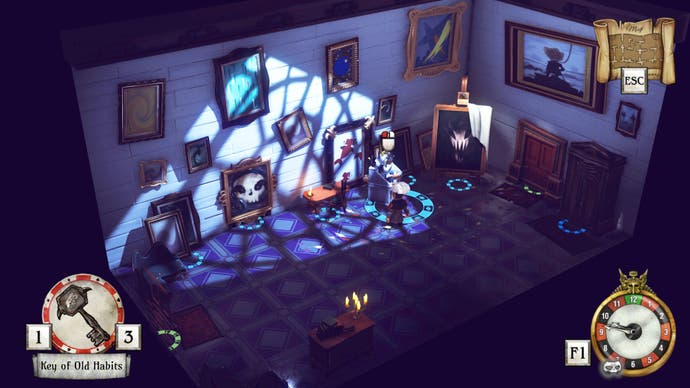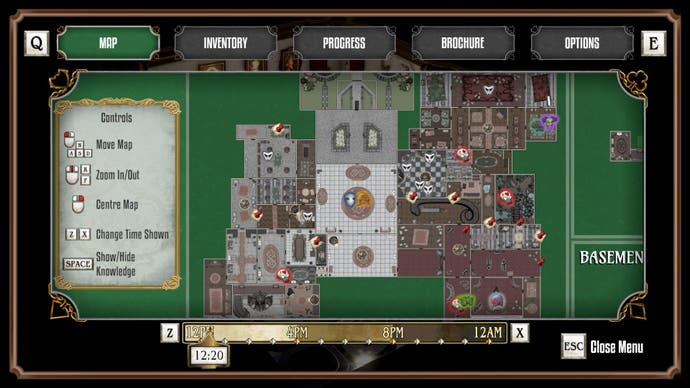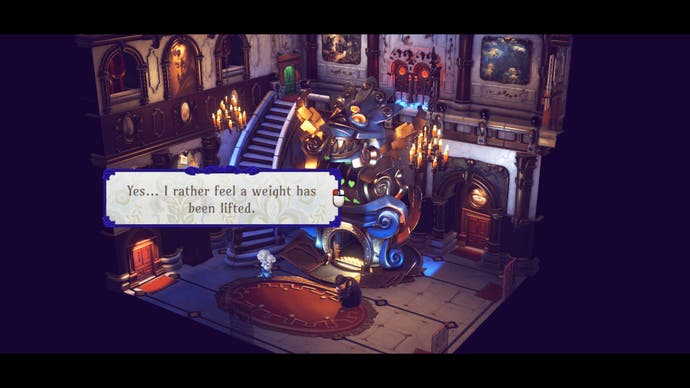The Sexy Brutale review
The fire in which we burn.
The Sexy Brutale has done a terrible, wonderful thing to me: it has turned the tempo of my thoughts into a symphony of carnage. Much as the Russian physiologist Ivan Pavlov conditioned dogs to dribble at the ring of a bell, so Cavalier's blend of Groundhog Day and Edgar Allan Poe has taught me to associate certain, innocuous noises with a variety of grisly deaths, drilling the connections into me as I wind and rewind its eternally recurring, seemingly inescapable Saturday.
If I hear a flurry of circus music, it means that somebody is about to be messily impaled. If I hear the beep of a door code followed by the clank of a grate, it means that somebody else is about to be eaten alive. These fateful cues and interruptions are now unsettlingly integral to how I navigate the game's mansion, allowing me to deduce the location and status of each unfortunate resident from ear alone. Its medley of violence has become part of my mental soundtrack, helping me pace out my exploration of its world.

Created by a trio of former Lionhead and MediaTonic developers with the aid of artists at publisher Tequila Works, The Sexy Brutale is an original, flamboyant and finely crafted spin on the murder-mystery genre, whose inspirations range from The Legend of Zelda: Majora's Mask to London's interactive theatre scene. It's the story of the party to end all parties, a masquerade ball thrown by an eccentric Marquis that has taken a turn for the murdery.
You play Lafcadio Boone, a priest who awakens in a library to find that the entire mansion has become caught in a vicious feedback loop, an endlessly repeated 12-hour orgy of destruction in which visitors are creatively butchered by a retinue of impeccably sadistic butlers among other, less explicable horrors. Boone alone of the party-goers is conscious of this and able to remember each loop's events, care of a blood-stained mask handed to him by a cadaverous spectre, who promptly vanishes into a pool of gore.
Your goal in the game is to learn the schedule in order to change it, tracking each guest's movements around the house and finding some way of averting their demise. Do so and you'll free the poor soul briefly from purgatory, allowing Boone to converse with them and gain a new ability which, in fine Metroidvania tradition, unlocks the route to another part of the building. Then you move onto the next character, no older but a little wiser as to the mansion's ultimate secret, while the character you've just saved returns to the cycle of death.

There are a few additional complications. For starters, Boone can't be in the same room as anybody else. The house's other occupants all have masks of their own, masks possessed of a sinister agency: stray within view and time will judder to a halt, interactive objects (save for door handles) will lock in place, and the other character's mask will fly across the room on a column of smoke, driving poor Boone into a stupor. As such, you can't interact with people directly. Instead you must stalk each character, room to room, peering through keyholes and eavesdropping on conversations, till you understand how they fit into the puzzle. From there, it's a question of manipulating the environment to avert catastrophe, racing your unsuspecting quarry to the key props like a parent sweeping dangerous objects out of the path of a meandering toddler.
Boone begins the game with an ornate pocket-watch that shows how close your current target is to his or her sticky end; this item also lets you reset the loop at will, so you don't have to wait around once you've worked out where you need to be and why. Other unlockable abilities include the power to begin the loop from any other clock in the mansion, shatter certain glass objects, light candles and pick locks. Most useful of all, though, is the map screen, which shows the position of every guest or servant in real-time - providing you've observed them at that point in the cycle - and lets you scrub back and forth between noon and midnight to follow their path from on high.
For all its arcane premise, convoluted workings and atmosphere of perpetual menace, the Sexy Brutale can be quite a restful game. You only have to save one person (or linked pair) at once, which stops the mass of overlapping character routines from becoming overwhelming, and the objects you'll need to interact with usually aren't too far from the people or things they relate to. The game's mouse controls - hold right-click to move to a point, left-click to interact - can feel a bit stiff, but once you've cracked a puzzle, the solution is rarely that fiddly to perform.

The feel is almost that of playing a clockmaker, rotating the gears of the world back and forth to identify the point at which they come awry. But that's of course to disregard the fact that the gears are people, personalities you'll come to know intimately as you dog them to their deaths again and again, scrutinising every last detour, gesture or scrap of dialogue for a hint as to their salvation.
Rendered as diminutive 3D caricatures with oversized, expressive faces, The Sexy Brutale's cast are recognisably cobbled together from pulp archetypes - there's the Southern belle wounded in love, the cocky master thief who just can't resist an obviously baited trap, the alcoholic prizefighter on a run of bad luck. But they're vividly sketched, and if the script's mixture of pathos and gallows humour isn't always dazzling, that's made up for by the distress of seeing each character perish over and over - and the complex disgust of realising, later in the game, that the exact place and time of each death has become a sort of navigational aid, a way of taking your bearings. In that regard, as I wrote at the beginning, The Sexy Brutale's abhorrent masterstroke is its audio design. Each death is linked to a sound, such as the crash of glass or a crackle of electricity, that is audible from several rooms away. Each section of the mansion also has its own orchestral score that crescendos whenever a resident is about to pop their clogs.
The mansion itself is a joy to roam, a baroque abomination made up of lavishly furnished dioramas viewed from a quasi-isometric perspective. It's a realm of sickly splendour, all stained glass windows, marble staircases, spiralling wooden columns and enormous, preposterous statues of mythical creatures. One chamber houses a gigantic brass furnace cast in the image of a phoenix, calling to mind the brazen bull in which certain criminals were roasted in Ancient Greece. Most rooms are lined with exquisite miniaturisations of classical portraiture and landscape art - Johannes Vermeer's Girl with a Pearl Earring, Francisco Goya's Saturn, Caspar David Friedrich's Wanderer above the Sea of Fog - remoulded to fit the game's cartoon proportions. The Goya painting is the first you'll lay eyes on, and a hint as to the game's predictable but poignant finale.

2016 may have been the year that time remembered, but in most video games, Time is a toothless entity, an irrelevance in thrall to Space. Today's open worlds may bill themselves as "living" environments, but it's hard to agree with that claim when those worlds are content to linger indefinitely, twiddling their thumbs while you fritter away the hours grinding out upgrades or chasing down every last sidequest.
This certainly makes for more restful escapism, but it doesn't make for much dramatic potency, because a world where time waits for you is a world without real hope, regret or tragedy. The Sexy Brutale isn't quite an unqualified triumph - the puzzles are a bit too gentle towards the finish, once you've got the layout down pat, and the story ends with a slightly graceless dollop of extended exposition. But it's a dazzling show of how a game can benefit from taking time seriously, and a tale of bloodshed that is as gripping as it is ghastly.




